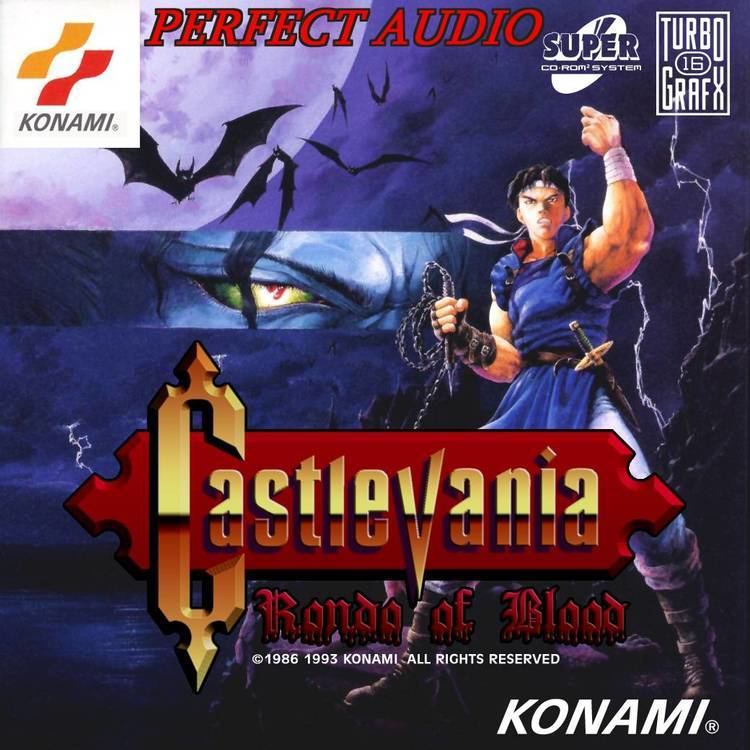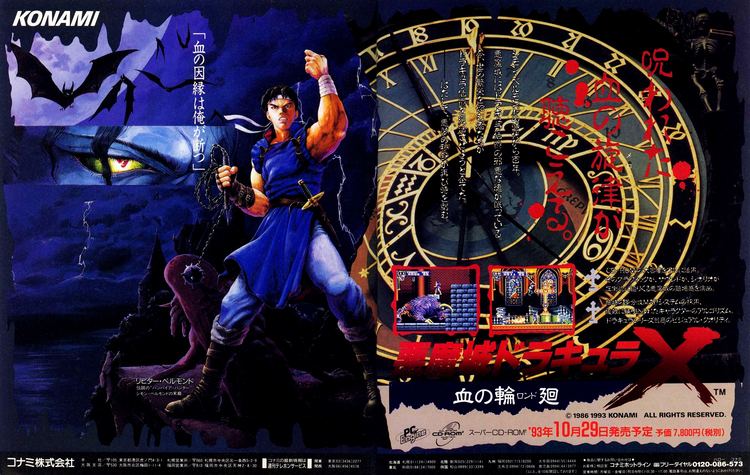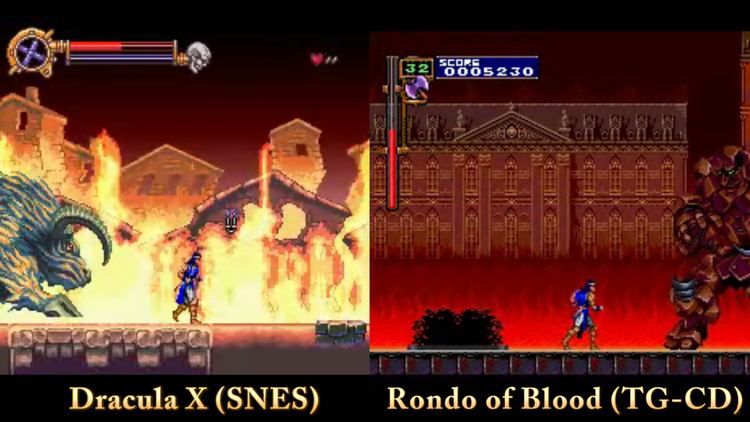9 /10 1 Votes9
Director(s) Toru Hagihara Mode(s) Single-player | 9/10 IGN Producer(s) Yoshiaki Yamada Initial release date 29 October 1993 Genre Platform game | |||||||||||||||||||||||||||||||||
 | ||||||||||||||||||||||||||||||||||
Artist(s) Toshiharu FurukawaReika BandoKoji Yamada Composer(s) Akira SoujiKeizo NakamuraTomoko SanoMikio Saito Release date(s) PC EngineJP: October 29, 1993Virtual ConsoleJP: April 22, 2008NA: March 15, 2010PAL: March 19, 2010 Similar Castlevania games, Konami games, Platform games | ||||||||||||||||||||||||||||||||||
Castlevania rondo of blood pc engine duo turboduo video game james mike mondays
Castlevania: Rondo of Blood, known in Japan as Akumajō Dracula X: Chi no Rondo (悪魔城ドラキュラX 血の
Contents
- Castlevania rondo of blood pc engine duo turboduo video game james mike mondays
- Castlevania rondo of blood pce playthrough nintendocomplete
- Gameplay
- Plot
- Development
- Audio
- Castlevania Dracula X
- Castlevania The Dracula X Chronicles
- Reception
- References

Castlevania rondo of blood pce playthrough nintendocomplete
Gameplay

The objective is to guide the primary player character Richter Belmont through nine stages, with four alternate routes, as he searches for his kidnapped beloved Annette and ultimately confronts Dracula in his castle. Richter makes use of a whip as his main weapon and one of six sub-weapons: an axe, a dagger, holy water, a grimoire, a pocket watch, and a cross. While exploring the castle, Richter can rescue four maidens, including his distant relative Maria Renard who then becomes a playable character. She attacks using her doves and one of six sub-weapons: a white tiger kitten, dragon whelp, baby phoenix, turtle, egg or musical notes. She is more agile, can do a double jump, and can do twice the amount of damage that Richter does in each normal attack because the doves she shoots out return to her and therefore can do a second hit of damage on the way back, but she takes much more damage each time she is hit than Richter does when he is hit.

Rondo of Blood incorporates elements from the earlier Castlevania games which typically featured linear gameplay and a member of the Belmont clan as the protagonist, and the later entries which emphasized untimed exploration of the environment. Rondo of Blood makes use of untimed stages with a clear beginning, but more than one ending to some levels; this then affects the subsequent environment, monsters, and boss monster that the player character encounters at the end of the level. Items such as money, hearts, and food can be found scattered throughout the areas. Rondo of Blood also features the Item Crash ability reused in subsequent Castlevania titles, which allows a sub-weapon to be used in a super attack. Its direct sequel, Castlevania: Symphony of the Night, reuses many of the monsters.
Plot
Taking place in 1792, Rondo of Blood is set in the fictional universe of the Castlevania series. The premise of the series is the eternal conflict between the vampire hunters of the Belmont clan and the immortal vampire Dracula. The protagonist is 19-year-old Richter Belmont (Jin Horikawa), heir to the whip Vampire Killer and Simon Belmont's direct descendant. He comes to the castle after his beloved Annette (Atsuko Honda) is kidnapped by Dracula's servant Shaft. Two times throughout the game, Dracula's trusty lieutenant, Death, attempts to stop Richter before he reaches Dracula. Along the way, Richter frees his distant relative Maria Renard (Yōko Teppōzuka), an orphaned 12-year-old who was taken to the castle with her and insists on joining him; Terra (Hiromi Murata), a nun who mistakes him for a manifestation of God; Iris (Akie Yasuda), the daughter of the village doctor; and finally Annette. After defeating Shaft and Death, Richter confronts Dracula (Hiroya Ishimaru) and vanquishes him. The castle then collapses into the sea.
Development
Rondo of Blood is the tenth installment of the Castlevania video game series. Produced by Konami, Rondo of Blood originally saw only a Japanese-exclusive release on the PC Engine on October 29, 1993. Later, a port was released on the Wii for the Japanese Virtual Console on April 22, 2008; as an import, it became available in North America on March 15, 2010 and in the PAL region (Europe and Australia) on March 19, 2010.
Audio
For the audio, Rondo of Blood makes use of Red Book Audio along with the onboard soundchip, allowing for better musical quality. Akira Souji, Keizo Nakamura, Tomoko Sano, and Mikio Saito composed the soundtrack of Rondo of Blood. The songs from Rondo of Blood, "Overture", "Beginning" and "Opus 13", appeared on a pre-order bonus CD for the 2006 Nintendo DS game Castlevania: Portrait of Ruin.
Konami Style published the two-disk soundtrack of the remake of the game, Castlevania: The Dracula X Chronicles, on November 8, 2007. The songs "Vampire Killer", "Beginning", "Cemetery", and "Divine Bloodlines" were rearranged; it also included a bonus track of an English-language version of "Nocturne" from Symphony of the Night. Within The Dracula X Chronicles is an option which enables players to choose songs from Rondo of Blood and Symphony of the Night to play in the background. These songs are found in the form of records hidden within the game.
Castlevania: Dracula X
Castlevania: Dracula X, known as Akumajou Dracula XX (悪魔城ドラキュラXX, Akumajō Dorakyura XX) in Japan and Castlevania: Vampire's Kiss in Europe, was developed for the Super Nintendo Entertainment System. While the plot is similar to Rondo of Blood and it uses many of the latter's graphics, it featured a different art style, redesigned levels, and altered gameplay elements (such as having only two alternate levels and Maria as a nonplayable character). It was released on July 21, 1995 in Japan, in September 1995 in the USA and Europe, and on June 22, 1996 in Australia as an uncensored release. The game was also released as a Wii U Virtual Console download in Japan on April 23, 2014, in North America on October 2, 2014 and the PAL regions on November 13, 2014. A version for the New Nintendo 3DS was released in North America on December 29, 2016, and in Europe and Australia on January 26, 2017.
Castlevania: The Dracula X Chronicles
Castlevania: The Dracula X Chronicles, known in Japan as Akumajō Dracula X Chronicle (悪魔城ドラキュラ Xクロニクル, Akumajō Dorakyura Ekkusu Kuronikuru, lit. "Devil's Castle Dracula X Chronicle") is a 2.5D remake of Rondo of Blood for the PlayStation Portable. It includes the original game and a port of its sequel, Symphony of the Night, as unlockable content. Symphony of the Night includes the option to play as Maria (as did the Sega Saturn version, but based on the Rondo of Blood version), as well as redone scripts, sound effects and new voice acting. Gameplay in The Dracula X Chronicles remains largely unchanged from Rondo of Blood. However, a Boss Rush mode was added; completion of it three times unlocks the mini-game Peke. It was released in North America on October 23, 2007, in Japan on November 8, 2007, in Europe on February 15, 2008 and in Australia & New Zealand on April 9, 2008. In 2008, the North American edition was re-released as part of the "Greatest Hits" label while the Japanese edition was re-released on July 15, 2010 under the "Best Selection" label. The game was added to the PlayStation Network in Europe in June 2014, as a PSP-only release (the game is already compatible with the PS Vita).
Reception
Reception to the PC Engine's Rondo of Blood was positive. Electronic Gaming Monthly stated that Rondo of Blood "can easily be the best CD title yet", and argued that the only bad point to it is that it would not be released in the USA. They later awarded the game Best Japanese Action Game of 1994. GamePro commented, "Declaring Dracula X to be the greatest Castlevania of all time would be a slap at Castlevania IV for the SNES, but earmarking X as one of the ten best side-scrollers of all time is a no-brainer." IGN awarded the Wii port its "Editors' Choice" and described it as enjoyable and "worth the wait". Corbie Dillard of Nintendo Life praised the level design, soundtrack, graphics, and level difficulty.
Castlevania: Dracula X for the Super NES received more mixed reviews, with most critics stating that it is an inferior conversion of the PC Engine game. On the release of the SNES port, Famicom Tsūshin scored Dracula X a 24 out of 40, and Electronic Gaming Monthly scored it a 6.75 out of 10, saying it is a good game in its own terms but does not hold up to previous Castlevania games. GamePro criticized that the stage design fails to encourage re-exploring stages, the bosses are not challenging enough, and the graphics and gameplay are primitive: "no knockout Mode 7 stages, no rotating rooms (like in Castlevania IV). Your character is also very small. The play engine feels like it's right out of the 8-bit versions ..." A critic for Next Generation panned it, saying it retains the by-then outdated graphics and controls of the PC Engine game and would not appeal even to die-hard Castlevania fans. He summarized it as "eight levels of no-frills side-scrolling action ... without an original or interesting thought in its wolfsbane-stuffed head." In contrast, IGN's retrospective on the series referred to it as "still one of the best traditional Castlevania games", and that it "holds its own" in terms of graphics, including a brighter color palette and Mode 7 graphics, but suffered from weak A.I. and bad level layout. It received a ranking of 73.75% from GameRankings, based on four reviews.
Critical reaction to the remake, The Dracula X Chronicles, was generally favorable. Metacritic listed The Dracula X Chronicles as 80/100 while Game Rankings gave it an 81.40%. Reviewers praised the updated visuals, enjoyable soundtrack, inclusion of Symphony of the Night and other bonus content. The high level of difficulty was noted by reviewers as potentially frustrating for players unused to it, and the voice acting drew criticism as "soap opera fare". Conversely, GameSpy called The Dracula X Chronicles "a solid remake", but considered it unnecessary and "worse than the original". Game Informer's Tim Turi felt it was a worthwhile remake of Rondo of Blood and praised its inclusion of it and Symphony of the Night as extra games. Jeremy Parish of 1UP described it as "a beautifully crafted action game in the classic Castlevania style" and a "long-coveted classic". GameZone ranked it as the fifth best Castlevania title. Like Game Informer, the staff praised the quality of the remake and the inclusion of the aforementioned games.
